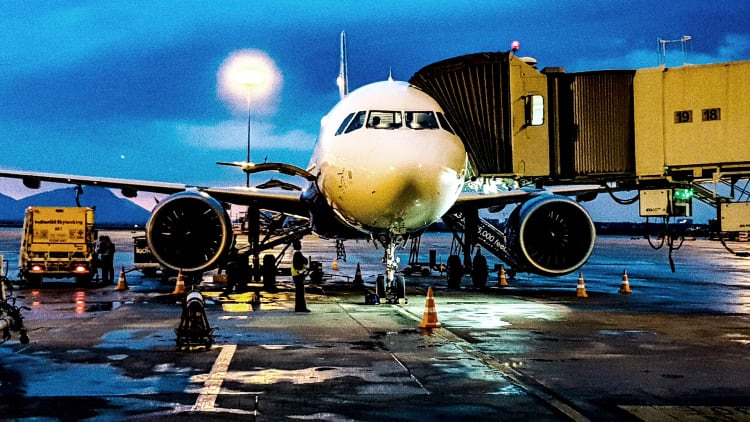- | 8:00 am
AI could decide what time your next flight takes off
Alaska Airlines is rolling out a predictive AI tool that will help it make informed decisions on the best use of its planes.

This spring, Alaska Airlines pushed back the time of its daily flight from Redmond, Oregon, to San Francisco by about an hour. That one change meant the flight arrived in San Francisco after many of the airline’s connections to the East Coast and Southern California departed, and passenger numbers plummeted.
“The route’s margin tanked by double-digits,” says Kirsten Amrine, vice president of revenue management and network planning at Alaska. “We just lost all sorts of guests because it no longer connected.”
Alaska moved the Redmond-San Francisco flight back to its original time this summer, but the problem of how to avoid potentially money-losing changes to its schedule, while rare, remained.
Airline schedules are complex puzzles. Everything from demand to airport ground staff, to flight connections go into the mix. And, as with the Redmond-San Francisco flight, the smallest change can mean the difference between a profit or loss, or even whether a flight operates on time, on any given route.
Enter Odysee, a startup supported by mobility tech incubator UP.Labs and Alaska’s investment arm, Alaska Star Ventures. Unveiled in October, the company is developing a predictive AI tool that helps airlines make informed decisions on the best use of its planes.
“We currently have to go and look at each flight that we’re changing individually,” says Amrine. “[But] with this product, we’re able to say ‘here’s the schedule I have now, I’m going to try this solution where I change the timings of six flights,’ push a button and it says ‘here’s what the revenue is’. It’s just much better than a human being can do on their own.”
Odysee’s schedule optimization tool uses machine learning techniques that combine multiple AI models to improve performance, in order to simulate and predict the revenue impact of potential changes to Alaska’s flights, according to the startup’s CEO Steve Casley.
The tool is trained on data from more than 700,000 Alaska flight segments from 2022 and 2023. And, when tested against the actual performance of flight changes made by human schedulers, it predicted the outcome with 90% accuracy, Casley says. Where the tool is weaker is in newer Alaska markets with limited data or ones with low travel demand.
“When a scheduler, let’s say, realizes there are three [flights] going into a city that has two gates [and] they need to move one of those flights by an hour, now they’re doing it intuitively,” says Casley. “What this product will do is, when they move that flight, it will show them several things: It will simulate the flow of that schedule for that [airplane] and determine if you’re impacting the potential for delay and predict the revenue.”
Applying AI’s capabilities to airline scheduling is a good use of the technology, says Pingbo Tang, a professor at Carnegie Mellon University whose research includes aviation applications of AI.
“This is a very reasonable solution for Alaska Airlines,” he says of Odysee’s analytics tool.
And for travelers who just want to know their flight will be on time, Odysee’s analytics could help ensure there are enough Alaska gates and ground staff throughout the day to keep a plane moving.
Alaska is in the testing phase with Odysee’s AI tool now. Casley expects it to be fully implemented in the first half of 2025. Future capabilities could include recommending potential new routes, as well as analyzing flight emissions or other sustainability metrics.
When fully implemented, Odysee will automatically analyze Alaska’s planned schedule changes to avoid mistakes like the Redmond-San Francisco flight and even recommend potentially beneficial changes. Humans will still have the final say on whether, for example, a flight leaves at 4 or 5 p.m. but with data supplied from the AI tool.
The early-2025 timeline also means Odysee should be up and running just in time for Alaska’s next big challenge: merging with Hawaiian Airlines. The deal will see Alaska add Hawaiian’s roughly 225 daily flights to its own 1,200 flights.
“We’re trying to put the airlines together and, if you can get AI to help you with that, that’s where you want to use it,” says Amrine.
Odysee is just the beginning for Alaska and UP.Labs. The pair agreed in 2023 to launch six startups aimed at solving “strategic challenges” for the aviation industry. Pasha Saleh, the head of Alaska Star Ventures and corporate development at Alaska, says the next startup will focus on airfares and launch by year-end, and the third on aircraft maintenance, which will debut in the spring.
“It has to have [an] impact beyond just our company,” says Saleh. “We want to be able to sell not just to other airlines but, if it’s really successful, other industries.”






































